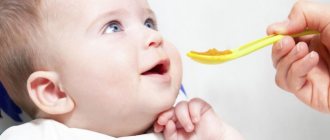One of the indicators of the successful functioning of a child’s body is the consistency and color of stool. No mother will remain indifferent to the non-standard appearance of the contents of a child’s potty, especially if she is not sure what such a symptom means. Light-colored stool in a child does not always require immediate medical attention, but it is worth knowing about the reasons for its occurrence so as not to miss a dangerous pathology.
Stool color in children - the norm and its variations
When breastfeeding, your stool should be yellow or apricot in color.
The stool of children and adults is colored by the bile pigment bilirubin, a derivative of erythrocytes, red blood cells. The liver filters out this pigment, then removes it through the bladder and intestines. It is considered normal for children's stool to be brown in various shades.
If this is the stool of a newborn or a baby under one year of breastfeeding, then it is predominantly yellow or apricot in color. For bottle-fed or mixed-fed babies, a cream, brown or gray tint is added to the traditional color, depending on the type of complementary foods or formula.
In children older than one year, the color of the stool can be affected by the foods the baby eats. Thus, beets give the contents of the pot a red color, carrots give them a bright orange color, and drugs taken for anemia turn them dark brown or black. The predominance of meat products in baby food also turns the stool dark brown.
Changes in baby's stool from birth to 1 year
What is the difference between the stool of a breastfed baby and the stool of a bottle-fed baby? How does stool change during the first year of life? When is loose stool normal, and in what situations is it a reason to panic? Today we will talk about this and much more with a pediatrician, author of books on the health, development and education of children Olesya Vladimirovna Butuzova.
— Olesya Vladimirovna, tell me, is the stool of a breastfed and bottle-fed baby different and what causes these differences?
— The first stool after the baby is born is meconium. It is approximately the same for everyone - thick, viscous and green due to the large amount of bilirubin. And then the child begins to eat mother’s milk or formula, and depending on the type of nutrition, his stool is formed.
How does the feces of a bottle-fed baby differ from the feces of a breastfed baby?
- First of all, color: many mixtures give a greenish color, and a breastfed baby’s stool will be yellowish.
- Secondly, the consistency: the stool is liquid in a baby with mother’s nutrition and thicker, pasty when using a formula.
- And, finally, frequency: after all, with artificial feeding, the baby poops less often.
— What stool can be considered normal for a breastfed baby?
— When analyzing a baby’s stool using breast milk, we take into account its color, consistency, smell, the presence of certain impurities or their absence.
- So, color:
yellow, brownish or orange. If the baby’s well-being is fine and the mother is only worried about the color, then, with a high degree of probability, everything is fine with the baby. - Consistency:
liquid in the first weeks, then gradually mushy. Normally liquid stool should not be confused with diarrhea. With diarrhea, the stool becomes watery, frequent, and acquires an unpleasant odor. May be accompanied by regurgitation, vomiting and fever. - Now let's talk about impurities and how to distinguish normal from pathology. Most often, mothers are bothered by white lumps in the stool
. In small quantities they are not a pathology. But their increase indicates that the child’s gastrointestinal tract is not quite able to digest food - either the baby is overeating, or the nursing mother eats a lot of fatty foods. - A small amount of mucus also does not bother us; this may be normal. But its abundance may indicate a violation of the intestinal flora or inflammation and still requires examination.
- Blood in the stool
is an alarming symptom. It can appear with constipation and diarrhea due to injury to the intestinal vessels, or it can be a consequence of inflammation of the intestines or anal fissure. In any case, it is important to consult a doctor immediately.
— What stool can be considered normal for a baby on formula?
— For a baby receiving formula, we evaluate the same parameters as during breastfeeding: color, consistency, smell, presence/absence of inclusions.
- Colour:
may be yellowish or green - do not be alarmed, some mixtures cause this coloration. - Consistency
: thicker than when breastfeeding, but the stool is still unformed. - Smell:
may have a slight, unnoticeable sourness. - Inclusions:
There should not be a large amount of mucus in the stool, as well as streaks of blood or undigested pieces of food.
— How does food affect a baby’s stool?
— If a child eats breast milk, then his stool largely depends on what his mother eats.
If a nursing woman overuses fatty, fried foods, white lumps appear in her baby's stool. An abundance of bread and buns in a mother’s diet leads to constipation and bloating in the child, and the predominance of raw vegetables and fruits can lead to diluted stool. Sweets can cause your stomach to growl.
- For what other reasons does the stool change?
— The most serious stool disorders in newborns are caused by congenital diseases such as celiac disease and lactase deficiency.
For celiac disease
The child’s body lacks an enzyme that helps digest gluten: rye, rice, and barley are rich in it. As a rule, before introducing complementary foods, we have no idea about this disease. But when rice porridge or bread appears in the diet, such a child’s intestines become inflamed, which is manifested by diarrhea, pain and rumbling in the stomach.
For lactase deficiency
Another deficiency is a lack of lactase, a special enzyme that helps digest milk sugar - lactose. We notice this disease literally from the first day through foamy and profuse diarrhea.
— How does a child’s stool normally change from birth to one year?
— With age, the frequency of bowel movements decreases. If a newborn could poop 10 times a day, then a one-year-old does this, as a rule, 1-2 times. The stool itself becomes thicker, becomes more shaped and brown in color.
What can a baby's stool tell the doctor?
| Chair type | When it meets | Why is it dangerous? |
| Liquid | Most often it is caused by improper introduction of complementary foods and teething. If diarrhea is accompanied by an increase in body temperature, it is important to consult a doctor without delay. | Diarrhea is dangerous due to dehydration - a dangerous condition for the baby that requires rapid restoration of the volume of lost fluid. |
| Foamy | In rare cases, such stool may be a reaction to new foods in the diet of a nursing mother. Most often, foam appears due to an allergic reaction or lactase deficiency. | Without the timely help of a competent doctor, severe digestive disorders and deficiency of nutrients, vitamins and microelements develop. |
| With mucus | The first couple of months, stool with a small amount of mucus can be considered normal. Pathological mucus impurities can appear when the timing of complementary feeding is violated, changes in the composition of the intestinal microflora, or inflammatory changes in the intestines. | It is important to get tested and determine the cause of such stool: in the absence of diagnosis and treatment, digestion may suffer. |
| White | The cause of stool discoloration is most often pathologies of the liver, gallbladder and biliary tract. Often such conditions are accompanied by darkening of the urine. | Such conditions may be accompanied by an increase in bilirubin in the blood, which negatively affects the nervous system. |
| With a sour smell | A pronounced sour odor may indicate indigestion due to a lack of enzymes, inflammation of the large intestine, or a violation of nutritional rules by a nursing mother. | Impaired digestion and absorption of nutrients. |
| Liquid | When it meets Most often it is caused by improper introduction of complementary foods and teething. If diarrhea is accompanied by an increase in body temperature, it is important to consult a doctor without delay. | Why is it dangerous? Diarrhea is dangerous due to dehydration - a dangerous condition for the baby that requires rapid restoration of the volume of lost fluid. |
| Foamy | When it meets In rare cases, such stool may be a reaction to new foods in the diet of a nursing mother. Most often, foam appears due to an allergic reaction or lactase deficiency. | Why is it dangerous? Without the timely help of a competent doctor, severe digestive disorders and deficiency of nutrients, vitamins and microelements develop. |
| With mucus | When it meets The first couple of months, stool with a small amount of mucus can be considered normal. Pathological mucus impurities can appear when the timing of complementary feeding is violated, changes in the composition of the intestinal microflora, or inflammatory changes in the intestines. | Why is it dangerous? It is important to get tested and determine the cause of such stool: in the absence of diagnosis and treatment, digestion may suffer. |
| White | When it meets The cause of stool discoloration is most often pathologies of the liver, gallbladder and biliary tract. Often such conditions are accompanied by darkening of the urine. | Why is it dangerous? Such conditions may be accompanied by an increase in bilirubin in the blood, which negatively affects the nervous system. |
| With a sour smell | When it meets A pronounced sour odor may indicate indigestion due to a lack of enzymes, inflammation of the large intestine, or a violation of nutritional rules by a nursing mother. | Why is it dangerous? Impaired digestion and absorption of nutrients. |
- Let's talk about the frequency and regularity of stool. What should they be?
— In the first month of his life, the baby sometimes poops as often as he latches onto the breast. As it grows, the frequency of stool decreases, but, in my opinion, it should not be less than once a day.
- Long-term absence of bowel movements - when to go to the doctor?
— This question is extremely debatable. There are pediatricians who claim that breast milk can be completely absorbed, so the baby may not poop for several days. I do not share their opinion and believe that stool should be at least once a day, and preferably several. It's not uncommon for newborns to poop after every feeding, and that's a good thing.
If suddenly there is no bowel movement within 24 hours, the baby needs to be helped to empty his bowels. When the situation repeats itself over and over again, you can start thinking about chronic constipation. It is important to see a doctor and start looking for the cause of constipation.
This may be poor nutrition of a nursing mother, digestive disorders or intestinal microflora in the baby.
The so-called “false constipation” deserves special attention - in such cases, there is no stool due to a lack of milk from the mother. Some pediatricians call such constipation hunger constipation. You can suspect a similar problem in children who do not gain weight well, sleep for a long time or, on the contrary, often ask for breastfeeding or are capricious.
— Traditional methods of combating constipation - why should you treat them with caution? Grandmothers advise to finish drinking, give the baby a drop of sour juice, give an enema...
— I categorically do not recommend using folk remedies. What experienced relatives won’t recommend to a young mother - a bar of soap, a cotton swab, the tip of a thermometer, early feeding with prunes, and sour juice. But the latter is not only ineffective, but also dangerous - you can injure the delicate intestinal mucosa and cause indigestion! I'm even against water enemas, especially on a regular basis. Now there are good remedies - microenemas in the form of a gel, effective and safe.
— How do MAMAKO® Premium formulas with goat milk help normalize a child’s stool?
— Let's start with the fact that these mixtures are based on goat's milk, which is digested and absorbed more easily than cow's milk.
In addition, MAMAKO® Premium contains pre- and probiotics that help restore the balance of intestinal microflora. And nucleotides that stimulate the maturation of the intestinal epithelium and the colonization of the intestines with the correct, beneficial bacteria.
Another important point is the absence of palm oil. The manufacturer replaced it with palmitic acid from milk fat, which reduces the likelihood of problems with stool.
- When can you not do without a doctor?
— It is important to consult a doctor without delay if a child regularly suffers from constipation or, on the contrary, thinning and frequent stools. Also, a reason for consulting a specialist is the presence of impurities in the stool in the form of copious amounts of mucus, undigested food or blood.
A child's stool is a marker of digestion and the condition of the entire body as a whole. Therefore, it is very important to know how it changes during the first year of life. This will help parents understand when there is no need to panic, and in what situations they need to immediately seek help from a specialist.
Pediatrician Olesya Vladimirovna Butuzova
*The ideal food for an infant is mother's milk. WHO recommends exclusive breastfeeding for the first 6 months. MAMAKO® supports this recommendation. Before introducing new foods into your baby’s diet, consult a specialist.
Changing your diet as a cause of light stools
The appearance of light-colored stools is usually very alarming for parents, but often the reason for this may simply be changes in the children's menu. Most often this is the consumption the day before of a large amount of dairy food with a high percentage of fat content - undiluted homemade milk, cream, cottage cheese, sour cream, fermented milk drinks. They can give the stool a light yellow or light cream tint.
The same color of stool may appear when a child eats a large amount of sweets. If the child feels well, does not show anxiety, there is no fever or abdominal pain, it is worth observing the stool for 1-2 days. Usually, after adjusting the diet, this symptom disappears.
Treatment methods for various diseases
The course of therapy is selected individually, depending on what caused the disorder.
Features of the treatment of pathologies that provoke stool discoloration:
| Disease | Features of therapy | Drugs used |
| Pancreatitis | The goal of treatment is to ensure peace, prevent damage to the pancreas, and eliminate the signs and cause of the pathology. The patient must adhere to a diet for 1-3 days. Specialists suction the stomach contents to prevent enzyme activation. When the pain decreases, you are allowed to eat boiled or steamed food, but without salt. The child should eat fractional liquid or semi-liquid meals. At the same time, medications are prescribed. | The patient is recommended to take enzyme preparations (Pancreatin, Mezim). It is also necessary to use:
In the case of a purulent bacterial process, antibacterial drugs are prescribed. |
| Dysbacteriosis | Treatment of the disease is complex. The patient is prescribed dietary nutrition and medications. The child's diet should contain products with bifidobacteria and lactobacilli. Drinking milk is prohibited, but you can replace it with yoghurt, kefir, and cottage cheese. To ensure sufficient intake of microelements into the body, vegetables, fruits, oatmeal, buckwheat, and millet porridge should be included in the menu. The diet should also contain foods rich in protein (lean meat and fish, boiled or steamed). It is recommended to feed artificial babies with special medicinal mixtures. | The first stage of therapy involves the use of drugs that destroy pathogenic microflora. For this purpose, it is recommended to take antibiotics and bacteriophages. Then replacement therapy with probiotics and prebiotics is used. To restore the microflora, use Linex, Bifiform, Lactobacterin. |
| Hepatitis | Treatment of the disease occurs in a hospital setting. Detoxification measures, symptomatic treatment are carried out, vitamins are prescribed to maintain and restore the liver. | Recommended use:
|
| Whipple's disease | Complex therapy consists of diet and taking medications and vitamin complexes. Treatment is long-term (1 year or more). Food should be light and high in protein. | Treatment is carried out using:
|
| Rotavirus infection | Treatment is symptomatic. It is also recommended to follow a diet excluding milk, fats, fresh vegetables and fruits. The child should consume semi-liquid cereals, jelly, and fermented milk products. | To eliminate signs of pathology, it is recommended to use:
|
Rotavirus infection and the contents of a child's potty
Fever and vomiting may be symptoms of rotavirus infection.
If, in addition to a change in the color of the stool, a child experiences an increase in temperature, as well as signs of intoxication such as diarrhea or vomiting (usually both of these signs), then it is quite possible that he has a rotavirus infection.
The stool changes color from light yellow on the first day to gray-white in the next two to three days. In addition to these symptoms, respiratory manifestations may appear: redness of the throat, runny nose, cough, as well as headache and abdominal pain.
Other reasons
Pediatricians say that very often a child’s light-colored stool appears during the period when his teeth begin to emerge. The nature of this phenomenon has not been fully studied, but the fact remains. Therefore, if the child does not exhibit any other symptoms, just carefully monitor the baby’s condition. And it is also necessary to notify the doctor.
Also remember if you gave your child any pharmacological drugs the day before. Many medications can cause a child's stool to become lighter in color.
In general, many young mothers report that their baby’s stool periodically becomes lighter in color. And my health does not suffer at all. Several days pass and the color of the stool returns to normal without any special measures.
Medicines that change stool color
This symptom may be a side effect when using certain categories of medications. Stool becomes discolored due to the liver's reaction to certain medications. They may be:
- Paracetamol
- Acetylsalicylic acid derivatives: Aspirin, Laspal
- Non-steroidal anti-inflammatory drugs: Ibuprofen, Diclofenac, Nimesulide
- Antifungal: Griseofulvin
- Antiepileptic drugs: Acediprol, Valproic acid, Convulex, Leptilan
If such a reaction to the use of drugs occurs, you should consult with the specialist who prescribed the treatment in order to avoid complications for the liver and gastrointestinal tract.
Features of treatment
Treatment is selected depending on the cause of the appearance of white plaque on the stool. Infectious origins should be treated with antimicrobial agents and antibiotics after consultation with a specialist. For diseases of the gastrointestinal tract, take Linex and similar probiotics that improve intestinal microflora. Eliminate fatty, fried and spicy foods from your baby's diet.
A plaque on a child's bottom is a sign of anal thrush. Ignoring the treatment of this disease leads to disturbances in the development of the baby’s body. For therapy, give your baby antifungal drugs to fight the pathogen. To eliminate itching, smear the child's anus with Fenistil ointment.
Dysbacteriosis and light stools
Dysbacteriosis in children can occur after taking antibiotics.
One of the side effects of taking antibiotics can be dysbiosis - a change in the balance of microflora in the intestines and stomach towards the predominance of pathogenic bacteria. This condition is manifested by a violation of the usual stool consistency, alternating diarrhea and constipation, and the appearance of light-colored stools with pieces of undigested food and mucus.
Loss of appetite, restless sleep, weight loss due to dysbiosis are also common. You should not attempt to correct this condition on your own; you should consult a gastroenterologist.
Most likely, he will advise taking prebiotics (Lactobacterin, Bifidumbacterin, Acipol), after which the stool should take on a normal color and consistency.
Possible complications
If you ignore the problem caused by the disease, serious consequences may occur:
- the pancreas will stop producing enzymes that help digest food;
- intoxication of the body will occur if the cause of the disorder is helminthiasis;
- dysbiosis will become chronic, which will lead to loss of appetite, constant bloating, vomiting and diarrhea;
- the functioning of the gallbladder and liver will worsen, bile stagnation will occur, and the risk of stone formation will increase.
The color of stool can change for various reasons. Many of them do not pose a danger to the child and do not require treatment. But if the poop remains white for several days, and the baby’s well-being suffers, it is necessary to consult a doctor as soon as possible. This condition may be a sign of serious problems in the functioning of the body and should not be ignored.
Teething
Something that seems to have absolutely no effect on the condition of the intestines, such as the eruption of baby teeth in a baby, can also affect the color of a child’s stool. Here you just have to be patient and try not to miss the appearance of respiratory or viral infections during this period of temporary decrease in immunity. It is not necessary that light-colored stools necessarily appear in all teething babies. However, if this symptom is accompanied by the following:
- swelling and redness of the gums
- restless and short sleep
- slight increase in temperature
- loose stool
- decreased appetite
To alleviate the condition, you can give a mild pain reliever and do not insist on feeding. After the teeth appear, the stool should return to normal.
Light-colored stools are a reason to get tested for hepatitis
Hepatitis can cause changes in a child's stool.
It is this reason that the child’s parents try to exclude when they see white stool, which is one of the signs of infection with the hepatitis virus. In addition, the following symptoms may be present:
- darkening of urine (dark beer color)
- pain in the right upper abdomen and severe bloating
- yellowing of the skin
- yellowing of the sclera of the eyes
- loss of appetite
- nausea
- heat.
To clarify the diagnosis, you need to contact a pediatrician or infectious disease specialist. Most likely, they will order laboratory tests to clarify the diagnosis. Hepatitis can also have a smoothed course, when there are no other symptoms except increased fatigue and pain in the right hypochondrium.
What to do if your child has diarrhea?
When a child develops white, loose stools, the daily dose of fluid consumed must be increased, since diarrhea in young children causes rapid dehydration, which threatens the baby’s life. You need to drink often and in small portions.
Can you eat bananas if you have diarrhea?
It is recommended to give a teaspoon of liquid every five minutes. You can drink it with non-carbonated mineral water, chamomile or fennel tea, jelly, compote, or rice broth.
In the first four hours, it is better for the child to refrain from eating so as not to overload the intestines (this does not apply to infants). Afterwards you need to stick to a diet. Mashed potatoes and porridge cooked in water (especially rice) are useful because they contain starch, which coats the walls of the stomach.
Fermented milk products containing bifidobacteria accelerate the restoration of normal intestinal microflora. If you have diarrhea, you should avoid all fried, fatty, hot and spicy foods, as well as foods that weaken and contain dietary fiber.
You need to stick to the diet for two weeks after recovery.
To eliminate diarrhea, the child needs to be given sorbents, for example, activated carbon or Smecta. These drugs remove toxins from the intestines, cleanse it of pathogenic microorganisms and envelop the walls, thereby protecting the digestive tract. Sorbents are sold in pharmacies without a doctor's prescription.
We should not forget about basic hygiene rules. Wash your child's hands after each visit to the toilet and before eating. In order not to cause irritation to the perianal area, you need to abandon regular toilet paper, it is better to wash it under running water.
If acts of defecation are so frequent that the skin around the anus is irritated, it is recommended to lubricate it with sea buckthorn oil or a cream containing panthenol. This will speed up regeneration and protect the baby's skin.









